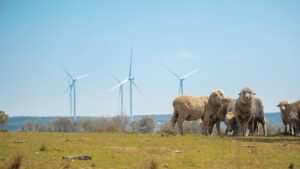Some of the world’s biggest investors in renewable energy and storage projects are seeking clarity from the Queensland government over its proposed new mandate to own at least half of the new capacity of wind, solar and storage in the state.
The new mandate was revealed in legislation released over the weekend that seeks to lock in the state’s newly advanced renewable energy targets – 70 per cent by 2032 and 80 per cent by 2035 – along with its existing goal of 50 per cent by 2030.
As the scale and timing of those targets indicate, the build out of renewables in the state with currently the biggest share of coal power is back-ended towards the end of this decade and into the early 2030s, but it will still require more than 22GW of new wind and solar and 12GW of storage capacity by 2035.
The state government has declared that new transmission and deep storage (the two huge pumped hydro projects planned for the Burdekin and Borumba) will be state owned, which is no surprise.
However, the Clean Energy Investors Group is concerned about the mandate that declares that more than half of new generation and shallow storage will still be state owned. The documents indicate a target of 54 per cent public ownership, which means state utilities emerging as equity partners in many projects.
CEIG represents some of the leading renewable investors in Australia, and the world. They include Neoen, Andrew Forrest’s Squadron Energy, Tilt Renewables, Macquarie, and global funds giant Blackrock and its battery storage offshoot Akaysha. Many have significant project pipelines in Queensland.
CEIG boss Simon Corbell, a former energy and climate minister for the ACT who played a key role in that territory’s 100 per cent renewable energy mandate, says the Queensland move has significant implications in terms of managing development pipelines.
“We’re not saying that this isn’t a legitimate public policy choice,” Corbell told RenewEconomy on Monday, ahead of the CEIG’s first investor conference on Tuesday and a planned visit to Brisbane to talk to the government later in the week.
“But it does need to be done in a way that encourages development. We will be having discussions with the government later this week to discuss detail of the decision, and we look forward to that meeting.”
Corbell says some of the potential issues will come as to how the mandate is managed, and the impact on projects involved.
Will all projects have to have an element of government ownership? Is there a timeline on the target? Will projects with state ownership be somehow favoured or prioritised for access in the newly created renewable energy zones?
Corbell also asks: It going to be a public transparent process? “It highlights the importance of competitive neutrality, which is to allow those projects not with government ownership to be treated equally.”
Government contracts, usually in the form of power purchase agreements, have been a common feature of the renewable and storage markets in recent years, but there is no a growing shift to public ownership.
The Victoria government is creating a new State Energy Corporation, which it wants to be a shareholder in at least 4GW of new renewable projects, while the NSW government is creating the Energy Security Commission, which will fund – either through loans or equity – investment in much needed pumped hydro.
Two of the most significant – and controversial – new energy projects in the country are being funded by the federal government though its Snowy Hydro utility, despite the fact that both projects are running well over time and budget.
The energy assets in both Western Australia and Tasmania are largely state owned, while South Australia – which leads the world with a 70 per cent share of wind and solar – relies on private ownership, although it is providing the funds for its planned green hydrogen electrolyser and hydrogen generator in Whyalla.
“We see a risk of a misalignment between public ownership and private expectations in how assets are going to be utilised, and managed,” Corbell says.
“If the only way to get a PPA is with a government corporation, and that means getting state equity, it could get some strange outcomes in PPA market.”








